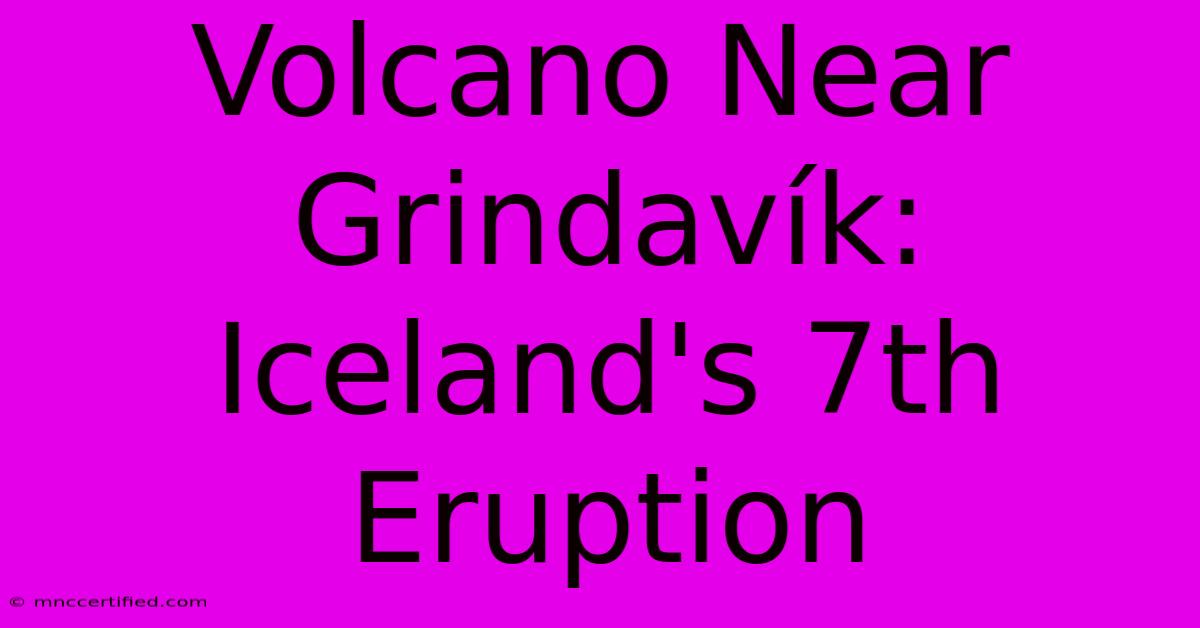Volcano Near Grindavík: Iceland's 7th Eruption

Table of Contents
Volcano Near Grindavík: Iceland's 7th Eruption in Recent Times
Iceland, the land of fire and ice, has once again captivated the world with its dramatic volcanic activity. A new eruption near Grindavík marks the country's seventh eruption in recent times, sparking both awe and concern. This article delves into the details of this fascinating event, exploring its geological context, impact on the surrounding area, and the ongoing monitoring efforts.
Understanding the Grindavík Eruption: A Geological Perspective
The eruption near Grindavík isn't a surprise to volcanologists. Iceland sits atop the Mid-Atlantic Ridge, a tectonic plate boundary where the North American and Eurasian plates meet. This geological setting fuels significant volcanic activity, making eruptions a relatively common, albeit dramatic, occurrence. The area around Grindavík is particularly active, lying within the Svartsengi volcanic system, known for its geothermal energy and frequent seismic activity. This specific eruption, however, is notable for its proximity to infrastructure and the potential impact on the nearby town.
The Svartsengi Volcanic System: A Hotbed of Activity
The Svartsengi volcanic system is characterized by a complex network of fissures and magma chambers. Prior to the eruption, the region experienced a significant increase in seismic activity – a clear indicator of magma movement beneath the surface. This increased seismic activity served as an important warning sign, allowing authorities to prepare for the potential eruption and evacuate residents from the immediate vicinity. Understanding the history and characteristics of this system is crucial for managing the risks associated with future eruptions.
The Impact of the Eruption: More Than Just Lava
While visually stunning, volcanic eruptions can have far-reaching consequences. The eruption near Grindavík presents various challenges:
- Lava flows: The immediate concern is the flow of lava, which poses a threat to infrastructure, including roads and potentially even buildings in Grindavík. The speed and direction of lava flows are constantly monitored, allowing for informed responses.
- Air quality: Volcanic gases, such as sulfur dioxide, can impact air quality, leading to respiratory problems. Air quality monitoring is crucial to inform public health warnings and protective measures.
- Tourism: While some may be deterred, others are drawn to witness the raw power of nature. The impact on tourism will depend on the eruption's duration and intensity, as well as the safety measures put in place.
Monitoring and Mitigation Efforts
Iceland's meteorological office, the Icelandic Meteorological Office (IMO), plays a vital role in monitoring volcanic activity. Using a range of techniques, including seismic monitoring, GPS measurements, and gas analysis, the IMO provides crucial data that informs evacuation plans and risk assessments. These efforts are essential for minimizing the impact of the eruption and ensuring public safety.
Iceland's Volcanic History: Putting the 7th Eruption into Context
This eruption near Grindavík adds to Iceland's already impressive record of volcanic activity. The country has experienced several significant eruptions in recent years, each offering valuable insights into volcanic processes and their impact. Studying these events, including the current eruption, allows scientists to refine their understanding of volcanic systems and improve prediction capabilities. This knowledge is not only crucial for Iceland but also for other volcanically active regions around the world.
Conclusion: A Spectacle and a Reminder
The eruption near Grindavík is a powerful reminder of the dynamic forces shaping our planet. While eruptions can be destructive, they also offer a unique opportunity to learn more about the Earth's processes and improve our preparedness for future events. The ongoing monitoring and response efforts demonstrate Iceland's commitment to managing volcanic risks effectively. As the eruption unfolds, scientists and authorities will continue to monitor the situation closely, ensuring the safety of the population and minimizing the impact on the environment.
Keywords: Iceland volcano, Grindavík eruption, Svartsengi volcanic system, Iceland volcanic activity, volcanic eruption, Mid-Atlantic Ridge, geothermal energy, seismic activity, lava flows, air quality, tourism impact, Icelandic Meteorological Office (IMO), volcanic monitoring, volcanic risk, natural disaster.

Thank you for visiting our website wich cover about Volcano Near Grindavík: Iceland's 7th Eruption. We hope the information provided has been useful to you. Feel free to contact us if you have any questions or need further assistance. See you next time and dont miss to bookmark.
Featured Posts
-
Pamela Hayden Simpsons Retirement
Nov 22, 2024
-
Linx Surgery Cost With Insurance
Nov 22, 2024
-
Penn State Hosts Food Science Summer School
Nov 22, 2024
-
Skubal And Sales Cy Young Season
Nov 22, 2024
-
Womens Champions League Live Arsenal Juventus
Nov 22, 2024